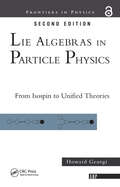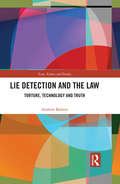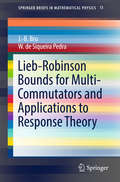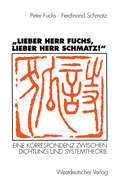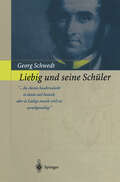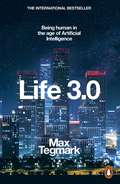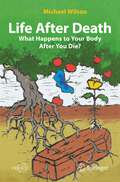- Table View
- List View
The Lidov-Kozai Effect - Applications in Exoplanet Research and Dynamical Astronomy (Astrophysics and Space Science Library #441)
by Ivan I. ShevchenkoThis book deals with an effect in celestial mechanics that has become quite important in exoplanet research. The Lidov-Kozai effect reveals itself in coherent periodic variations (which can be very large) of the inclination and eccentricity of an orbiting body in the presence of an inclined perturber. The effect is known to be important in the motion of many asteroids and planetary satellites. What is more, now it attracts more and more interest in the astronomical and astrophysical community due to its relevance for many exoplanetary systems. Recent years witnessed major advancements in its theory. It would be no exaggeration to say that nowadays the Lidov-Kozai effect becomes one of the most studied astrophysical effects. This book covers the multitude of the Lidov-Kozai effect’s modern applications and its theory developments. It will be useful for researchers and students working in astrophysics, celestial mechanics, stellar dynamics, theoretical mechanics, space missions design, depending on the interests of the reader. The book is self-contained. It provides the full detailed coverage of the effect’s theory and applications.
Lie Algebras and Applications (Lecture Notes in Physics #891)
by Francesco IachelloThis course-based primer provides an introduction to Lie algebras and some of their applications to the spectroscopy of molecules, atoms, nuclei and hadrons. In the first part, it concisely presents the basic concepts of Lie algebras, their representations and their invariants. The second part includes a description of how Lie algebras are used in practice in the treatment of bosonic and fermionic systems. Physical applications considered include rotations and vibrations of molecules (vibron model), collective modes in nuclei (interacting boson model), the atomic shell model, the nuclear shell model, and the quark model of hadrons. One of the key concepts in the application of Lie algebraic methods in physics, that of spectrum generating algebras and their associated dynamic symmetries, is also discussed. The book highlights a number of examples that help to illustrate the abstract algebraic definitions and includes a summary of many formulas of practical interest, such as the eigenvalues of Casimir operators, and the dimensions of the representations of all classical Lie algebras.For this new edition, the text has been carefully revised and expanded; in particular, a new chapter has been added on the deformation and contraction of Lie algebras.From the reviews of the first edition:"Iachello has written a pedagogical and straightforward presentation of Lie algebras [...]. It is a great text to accompany a course on Lie algebras and their physical applications."(Marc de Montigny, Mathematical Reviews, Issue, 2007 i)"This book [...] written by one of the leading experts in the field [...] will certainly be of great use for students or specialists that want to refresh their knowledge on Lie algebras applied to physics. [...] An excellent reference for those interested in acquiring practical experience [...] and leaving the embarrassing theoretical presentations aside."(Rutwig Campoamor-Stursberg, Zentralblatt MATH, Vol. 1156, 2009)
Lie Algebras and Applications (Lecture Notes in Physics #708)
by Francesco IachelloThis book, designed for advanced graduate students and post-graduate researchers, introduces Lie algebras and some of their applications to the spectroscopy of molecules, atoms, nuclei and hadrons. The book contains many examples that help to elucidate the abstract algebraic definitions. It provides a summary of many formulas of practical interest, such as the eigenvalues of Casimir operators and the dimensions of the representations of all classical Lie algebras.
Lie Algebras In Particle Physics: from Isospin To Unified Theories
by Howard GeorgiHoward Georgi is the co-inventor (with Sheldon Glashow) of the SU(5) theory. This extensively revised and updated edition of his classic text makes the theory of Lie groups accessible to graduate students, while offering a perspective on the way in which knowledge of such groups can provide an insight into the development of unified theories of strong, weak, and electromagnetic interactions.
Lie Detection and the Law: Torture, Technology and Truth (Law, Science and Society)
by Andrew BalmerThis book develops a sociological account of lie detection practices and uses this to think about lying more generally. Bringing together insights from sociology, social history, socio-legal studies and science and technology studies (STS), it explores how torture and technology have been used to try to discern the truth. It examines a variety of socio-legal practices, including trial by ordeal in Europe, the American criminal jury trial, police interrogations using the polygraph machine, and the post-conviction management of sex offenders in the USA and the UK. Moving across these different contexts, it articulates how uncertainties in the use of lie detection technologies are managed, and the complex roles they play in legal spaces. Alongside this story, the book surveys some of the different ways in which lying is understood in philosophy, law and social order. Lie Detection and the Law will be of interest to STS researchers, socio-legal scholars, criminologists and sociologists, as well as others working at the intersections of law and science.
Lie Detection and the Law: Torture, Technology and Truth (Law, Science and Society)
by Andrew BalmerThis book develops a sociological account of lie detection practices and uses this to think about lying more generally. Bringing together insights from sociology, social history, socio-legal studies and science and technology studies (STS), it explores how torture and technology have been used to try to discern the truth. It examines a variety of socio-legal practices, including trial by ordeal in Europe, the American criminal jury trial, police interrogations using the polygraph machine, and the post-conviction management of sex offenders in the USA and the UK. Moving across these different contexts, it articulates how uncertainties in the use of lie detection technologies are managed, and the complex roles they play in legal spaces. Alongside this story, the book surveys some of the different ways in which lying is understood in philosophy, law and social order. Lie Detection and the Law will be of interest to STS researchers, socio-legal scholars, criminologists and sociologists, as well as others working at the intersections of law and science.
Lie-Gruppen und Lie-Algebren in der Physik: Eine Einführung in die mathematischen Grundlagen (Springer-Lehrbuch)
by Manfred BöhmLie-Gruppen sind ein unverzichtbares Werkzeug in der Quantenmechanik, der Quantenchromodynamik und für Eichtheorien. Die algebraische Struktur dieser mathematischen Gruppen bildet in der Physik die Grundlage, um die Eigenschaften von Symmetrien zu beschreiben. Das einzige deutschsprachige Lehrbuch zum Thema liefert neben grundlegenden Kapiteln über Gruppen und algebraische Darstellung eine detaillierte Einführung zu Lie-Gruppen und Lie-Algebren. Anschließend können Leser den Stoff anhand der Berechnung weiterführender Lie-Algebren vertiefen.
Lie Theory and Its Applications in Physics: Varna, Bulgaria, June 2015 (Springer Proceedings in Mathematics & Statistics #191)
by Vladimir DobrevThis volume presents modern trends in the area of symmetries and their applications based on contributions from the workshop "Lie Theory and Its Applications in Physics", held near Varna, Bulgaria, in June 2015. Traditionally, Lie theory is a tool to build mathematical models for physical systems.Recently, the trend has been towards geometrization of the mathematical description of physical systems and objects. A geometric approach to a system yields in general some notion of symmetry, which is very helpful in understanding its structure. Geometrization and symmetries are employed in their widest sense, embracing representation theory, algebraic geometry, number theory, infinite-dimensional Lie algebras and groups, superalgebras and supergroups, groups and quantum groups, noncommutative geometry, symmetries of linear and nonlinear partial differential operators (PDO), special functions, and others. Furthermore, the necessary tools from functional analysis are included.This is a large interdisciplinary and interrelated field, and the present volume is suitable for a broad audience of mathematicians, mathematical physicists, and theoretical physicists, including researchers and graduate students interested in Lie Theory.
Lie Theory and Its Applications in Physics: Varna, Bulgaria, June 2019 (Springer Proceedings in Mathematics & Statistics #335)
by Vladimir DobrevThis volume presents modern trends in the area of symmetries and their applications based on contributions to the workshop "Lie Theory and Its Applications in Physics" held near Varna (Bulgaria) in June 2019. Traditionally, Lie theory is a tool to build mathematical models for physical systems. Recently, the trend is towards geometrization of the mathematical description of physical systems and objects. A geometric approach to a system yields in general some notion of symmetry, which is very helpful in understanding its structure. Geometrization and symmetries are meant in their widest sense, i.e., representation theory, algebraic geometry, number theory, infinite-dimensional Lie algebras and groups, superalgebras and supergroups, groups and quantum groups, noncommutative geometry, symmetries of linear and nonlinear partial differential operators, special functions, and others. Furthermore, the necessary tools from functional analysis are included. This is a large interdisciplinary and interrelated field. The topics covered in this volume from the workshop represent the most modern trends in the field : Representation Theory, Symmetries in String Theories, Symmetries in Gravity Theories, Supergravity, Conformal Field Theory, Integrable Systems, Polylogarithms, and Supersymmetry. They also include Supersymmetric Calogero-type models, Quantum Groups, Deformations, Quantum Computing and Deep Learning, Entanglement, Applications to Quantum Theory, and Exceptional Quantum Algebra for the standard model of particle physics This book is suitable for a broad audience of mathematicians, mathematical physicists, and theoretical physicists, including researchers and graduate students interested in Lie Theory.
Lieb-Robinson Bounds for Multi-Commutators and Applications to Response Theory (SpringerBriefs in Mathematical Physics #13)
by J. B. Bru W. de Siqueira PedraLieb-Robinson bounds for multi-commutators are effective mathematical tools to handle analytic aspects of infinite volume dynamics of non-relativistic quantum particles with short-range, possibly time-dependent interactions.In particular, the existence of fundamental solutions is shown for those (non-autonomous) C*-dynamical systems for which the usual conditions found in standard theories of (parabolic or hyperbolic) non-autonomous evolution equations are not given. In mathematical physics, bounds on multi-commutators of an order higher than two can be used to study linear and non-linear responses of interacting particles to external perturbations. These bounds are derived for lattice fermions, in view of applications to microscopic quantum theory of electrical conduction discussed in this book. All results also apply to quantum spin systems, with obvious modifications. In order to make the results accessible to a wide audience, in particular to students in mathematics with little Physics background, basics of Quantum Mechanics are presented, keeping in mind its algebraic formulation. The C*-algebraic setting for lattice fermions, as well as the celebrated Lieb-Robinson bounds for commutators, are explained in detail, for completeness.
Liebe und Sexualität in der zweiten Lebenshälfte: Problemlösungen und Behandlungen
by Schuhmann Graf-Baumann„Lieber Herr Fuchs, lieber Herr Schmatz!“: Eine Korrespondenz zwischen Dichtung und Systemtheorie
by Peter Fuchs Ferdinand SchmatzModerne Lyrik ist, jedenfalls sagt man ihr das nach, eine fatal schwierige und dunkle Angelegenheit. Sie scheint von Verstehenserschwernis auszugehen und sich wenig darum zu scheren, ob jemand ihre Gedichte versteht. Das reizte den systemtheoretisch orientierten Soziologen Peter Fuchs so sehr, daß er mit dem Wiener Lyriker Ferdinand Schmatz eine Korrespondenz aufnahm, die sich der Frage widmet, warum und ob überhaupt moderne Lyrik dunkel ist und welche Funktion ein derart aufwendiges Produzieren und Verstehen schwieriger Texte in der modernen Gesellschaft haben könnte. In diesem Briefwechsel prallen zwei Welten aufeinander, Wissenschaft und Kunst, zwei Welten, deren Exponenten eine leidenschaftliche Auseinandersetzung führen - bis hin zum Beinaheabbruch des Briefwechsels. Dabei entsteht ein faszinierendes Stück einer völlig unüblichen aber gleichwohl eindringlichen und erhellenden Wissenschaftsliteratur.
Liebig und seine Schüler: Die neue Schule der Chemie
by Georg SchwedtDieses Werk zu Liebigs 200. Geburtstag setzt die Schwerpunkte auf Liebigs eigene Ausbildung und die von ihm entwickelte weitreichende Schule der Chemie.Viele seiner Schüler werden bedeutende Wissenschaftler, Hochschullehrer, wissenschaftliche Schriftsteller und Industriechemiker. Sie kommen nicht nur aus Deutschland sondern aus vielen Ländern Europas, und sogar aus Nord- und Südamerika. Anhand der veröffentlichten Selbstzeugnisse Liebigs, seines umfangreichen Briefwechsels mit WÖHLER, BERZELIUS, dem Verleger VIEWEG und Schülern wie HOFMANN u.a. wird das Wirken Liebigs für eine neue Schule der Chemie dargestellt. Die Biographien der bedeutendsten Schüler werden im Zusammenhang mit Liebigs Einfluss auf die Entwicklung der Chemie in Europa und in den USA behandelt und mit zahlreichen Zitaten aus seinem Briefwechsel ergänzt.
Lieder für den Einzelgesang: zum Gebrauch an Lehrerbildungsanstalten und Musikschulen herausgegeben
by Georg RolleDieser Buchtitel ist Teil des Digitalisierungsprojekts Springer Book Archives mit Publikationen, die seit den Anfängen des Verlags von 1842 erschienen sind. Der Verlag stellt mit diesem Archiv Quellen für die historische wie auch die disziplingeschichtliche Forschung zur Verfügung, die jeweils im historischen Kontext betrachtet werden müssen. Dieser Titel erschien in der Zeit vor 1945 und wird daher in seiner zeittypischen politisch-ideologischen Ausrichtung vom Verlag nicht beworben.
Life: Differentiation and Harmony ... Vegetal, Animal, Human (Analecta Husserliana #57)
by M. Kronegger Anna-Teresa TymienieckaIn her Introduction, Tymieniecka states the core theme of the present book sharply: Is culture an excess of nature's prodigious expansiveness - an excess which might turn out to be dangerous for nature itself if it goes too far - or is culture a 'natural', congenial prolongation of nature-life? If the latter, then culture is assimilated into nature and thus would lose its claim to autonomy: its criteria would be superseded by those of nature alone. Of course, nature and culture may both still be seen as being absorbed by the inner powers of specifically human inwardness, on which view, human being, caught in its own transcendence, becomes separated radically in kind from the rest of existence and may not touch even the shadow of reality except through its own prism. Excess, therefore, or prolongation? And on what terms? The relationship between culture and nature in its technical phase demands a new elucidation. Here this is pursued by excavating the root significance of the 'multiple rationalities' of life. In contrast to Husserl, who differentiated living types according to their degree of participation in the world, the phenomenology of life disentangles living types from within the ontopoietic web of life itself. The human creative act reveals itself as the Great Divide of the Logos of Life - a divide that does not separate but harmonizes, thus dispelling both naturalistic and spiritualistic reductionism.
Life: Chapters 1-20
by David Sadava David Hillis H HellerThe Eleventh Edition of Life: The Science of Biology is engaging, active, and focused on teaching the skills that students need in the majors biology course. New pedagogical features grab students’ attention and give them a clear learning path through the text. Active learning is a priority throughout the text and media, including in the brand new and unique Active Learning Guide, giving instructors the support they need to encourage students to "learn by doing." Life continues and improves its focus on experiments and data, ensuring that students learn the skills they need to succeed in their careers. It is this potent combination of expertly crafted pedagogy and engagement that make this new edition the best resource for biology students. The Eleventh Edition of Life: The Science of Biology retains its reputation as the book with the highest quality content, clarity of language, and experimental emphasis, and the new focus and features make it a Life worth investigating. This textbook is available with LaunchPad. LaunchPad combines an interactive ebook with high-quality multimedia content and ready-made assessment options, including LearningCurve adaptive quizzing. See ‘Instructor Resources’ and ‘Student Resources’ for further information.
Life 3.0: Being Human in the Age of Artificial Intelligence
by Max Tegmark'This is the most important conversation of our time, and Tegmark's thought-provoking book will help you join it' Stephen HawkingTHE INTERNATIONAL BESTSELLER. DAILY TELEGRAPH AND THE TIMES BOOKS OF THE YEARAI is the future - but what will that future look like? Will superhuman intelligence be our slave, or become our god?Taking us to the heart of the latest thinking about AI, Max Tegmark, the MIT professor whose work has helped mainstream research on how to keep AI beneficial, separates myths from reality, utopias from dystopias, to explore the next phase of our existence.How can we grow our prosperity through automation, without leaving people lacking income or purpose? How can we ensure that future AI systems do what we want without crashing, malfunctioning or getting hacked? Should we fear an arms race in lethal autonomous weapons? Will AI help life flourish as never before, or will machines eventually outsmart us at all tasks, and even, perhaps, replace us altogether? 'This is a rich and visionary book and everyone should read it' The Times
Life After a Rare Brain Tumour and Supplementary Motor Area Syndrome: Awake Behind Closed Eyes (After Brain Injury: Survivor Stories)
by Alex Jelly Adel Helmy Barbara A. WilsonThis book offers a personal insight into the experience of Alex Jelly, a professional fundraiser who developed a rare brain tumour, a papillary meningioma, which was successfully removed. She was left with Supplementary Motor Area Syndrome and associated problems including motor and speech impairments and a temporary psychosis. Discussing Alex’s struggles and triumphs throughout her rehabilitation, this book offers an honest account of her journey from diagnosis to recovery. Part I introduces Alex’s early life and employment, symptom onset and diagnosis, treatment and rehabilitation. Part II presents her neurosurgeon, Adel Helmy, and a clinical neuropsychologist, Barbara A. Wilson. Adel provides a medical context by explaining Alex’s successful surgery and her post-operative experience. Finally, Barbara concludes with a comprehensive view of Alex’s recovery and gives a voice to the therapists and psychologists who worked with Alex throughout her in and outpatient rehabilitation journey. This book provides support, understanding and hope for patients who have suffered a brain tumour, and their families. It is valuable reading for any professional involved in neurorehabilitation, studemts of clinical neuropsychology and those touched by brain injury.
Life After a Rare Brain Tumour and Supplementary Motor Area Syndrome: Awake Behind Closed Eyes (After Brain Injury: Survivor Stories)
by Alex Jelly Adel Helmy Barbara A. WilsonThis book offers a personal insight into the experience of Alex Jelly, a professional fundraiser who developed a rare brain tumour, a papillary meningioma, which was successfully removed. She was left with Supplementary Motor Area Syndrome and associated problems including motor and speech impairments and a temporary psychosis. Discussing Alex’s struggles and triumphs throughout her rehabilitation, this book offers an honest account of her journey from diagnosis to recovery. Part I introduces Alex’s early life and employment, symptom onset and diagnosis, treatment and rehabilitation. Part II presents her neurosurgeon, Adel Helmy, and a clinical neuropsychologist, Barbara A. Wilson. Adel provides a medical context by explaining Alex’s successful surgery and her post-operative experience. Finally, Barbara concludes with a comprehensive view of Alex’s recovery and gives a voice to the therapists and psychologists who worked with Alex throughout her in and outpatient rehabilitation journey. This book provides support, understanding and hope for patients who have suffered a brain tumour, and their families. It is valuable reading for any professional involved in neurorehabilitation, studemts of clinical neuropsychology and those touched by brain injury.
Life After Brain Injury: Survivors' Stories (After Brain Injury: Survivor Stories)
by Barbara A. Wilson Jill Winegardner Fiona AshworthThis is the first book of its kind to include the personal accounts of people who have survived injury to the brain, along with professional therapists' reports of their progress through rehabilitation. The paintings and stories of survivors combine with experts' discussions of the theory and practice of brain injury rehabilitation to illustrate the ups and downs that survivors encounter in their journey from pre-injury status to insult and post-injury rehabilitation. Wilson, Winegardner and Ashworth's focus on the survivors' perspective shows how rehabilitation is an interactive process between people with brain injury, health care staff, and others, and gives the survivors the chance to tell their own stories of life before their injury, the nature of the insult, their early treatment, and subsequent rehabilitation. Presenting practical approaches to help survivors of brain injury achieve functionally relevant and meaningful goals, Life After Brain Injury: Survivors’ Stories will help all those working in rehabilitation understand the principles involved in holistic brain injury rehabilitation and how these principles, combined with theory and models, translate into clinical practice. This book will be of great interest to anyone who wishes to extend their knowledge of the latest theories and practices involved in making life more manageable for people who have suffered damage to the brain. Life After Brain Injury: Survivors’ Stories will also be essential for clinical psychologists, neuropsychologists, and anybody dealing with acquired brain injury whether they be a survivor of a brain injury themselves, a relative, a friend or a carer.
Life After Brain Injury: Survivors' Stories (After Brain Injury: Survivor Stories)
by Barbara A. Wilson Jill Winegardner Fiona AshworthThis is the first book of its kind to include the personal accounts of people who have survived injury to the brain, along with professional therapists' reports of their progress through rehabilitation. The paintings and stories of survivors combine with experts' discussions of the theory and practice of brain injury rehabilitation to illustrate the ups and downs that survivors encounter in their journey from pre-injury status to insult and post-injury rehabilitation. Wilson, Winegardner and Ashworth's focus on the survivors' perspective shows how rehabilitation is an interactive process between people with brain injury, health care staff, and others, and gives the survivors the chance to tell their own stories of life before their injury, the nature of the insult, their early treatment, and subsequent rehabilitation. Presenting practical approaches to help survivors of brain injury achieve functionally relevant and meaningful goals, Life After Brain Injury: Survivors’ Stories will help all those working in rehabilitation understand the principles involved in holistic brain injury rehabilitation and how these principles, combined with theory and models, translate into clinical practice. This book will be of great interest to anyone who wishes to extend their knowledge of the latest theories and practices involved in making life more manageable for people who have suffered damage to the brain. Life After Brain Injury: Survivors’ Stories will also be essential for clinical psychologists, neuropsychologists, and anybody dealing with acquired brain injury whether they be a survivor of a brain injury themselves, a relative, a friend or a carer.
Life After Carbon
by Peter Plastrik John ClevelandThe future of our cities is not what it used to be. The modern-city model that took hold globally in the twentieth century has outlived its usefulness. It cannot solve the problems it helped to create—especially global warming. Fortunately, a new model for urban development is emerging in cities to aggressively tackle the realities of climate change. It transforms the way cities design and use physical space, generate economic wealth, consume and dispose of resources, exploit and sustain the natural ecosystems, and prepare for the future.In Life After Carbon, urban sustainability consultants Pete Plastrik and John Cleveland assemble this global pattern of urban reinvention from the stories of 25 "innovation lab" cities across the globe—from Copenhagen to Melbourne. A city innovation lab is the entire city—the complex, messy, real urban world where innovations must work. It is a city in which government, business, and community leaders take to heart the challenge of climate change and converge on the radical changes that are necessary. They free downtowns from cars, turn buildings into renewable-energy power plants, re-nature entire neighborhoods, incubate growing numbers of clean-energy and smart-tech companies, convert waste to energy, and much more. Plastrik and Cleveland show that four transformational ideas are driving urban climate innovation around the world, in practice, not just in theory: carbon-free advantage, efficient abundance, nature's benefits, and adaptive futures. And these ideas are thriving in markets, professions, consumer trends, community movements, and "higher" levels of government that enable cities.Life After Carbon presents the new ideas that are replacing the pillars of the modern-city model, converting climate disaster into urban opportunity, and shaping the next transformation of cities worldwide. It will inspire anyone who cares about the future of our cities, and help them to map a sustainable path forward.
Life After Death: What Happens to Your Body After You Die? (Springer Praxis Books)
by Michael WilsonDeath is not an end – it’s a new beginning. After death, all of the molecules that came together to form the living “you” become nutrients for millions of creatures, large and small. Your body becomes the hub of a complex ecosystem of microbes, insects, worms, plants and more. Cheer up! This book shows how you are going to live forever – as components of so many other wonderful creatures. It describes the science behind the remarkable recycling of your body. We begin with lessons about how your body functions, is a collection of valuable nutrients and is a home to millions of microbes. The book goes on to describe the various stages the body passes through as it decomposes following death. The microbes and insects that make use of your tissues are then introduced. Finally, you will learn about the enduring effects that your body will have on the wider biosphere. We are rich in valuable resources that will end up feeding an immense number and variety of other creatures. Inevitably, your body will support the continuation of life on our beautiful planet – this book describes how all this happens.



